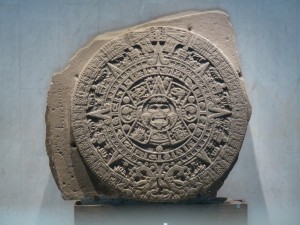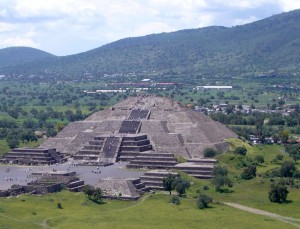Starbucks has agreed to pay intellectual property rights to the Mexican government for unauthorized use of Aztec images on a set of mugs.
The images were of the Aztec calendar stone, a basalt monolith found under Mexico City’s central square in the 18th century, and the Temple of the Moon in Teotihuacan.
Starbucks Mexico said Thursday that the supplier of the mugs had sought approval for the images from government archaeological agency since 2008, but had failed to receive it.
“Starbucks Mexico assumes responsibility … and is prepared to pay the amount corresponding to the use of these images,” a statement said, apologizing for “any misunderstanding.”
I’m pretty sure you don’t get to use images just because the rights holders don’t answer your queries, and I’m pretty sure Starbucks is aware of that.
Anyway, the mugs have been removed from the shelves for now while they settle the amount to be paid. A decision is expected next week. All that’s certain is that they’re going to make them pay.


I am intrigued. I’m pretty sure whoever carved the calendar stone is no longer with us, so how did the intellectual property in images of the stone end up with the Mexican government? Did you have to get permission for the picture in your post?
It could be worse…
In Machu Picchu, the calender stone is missing a piece as a camera doing a beer commercial hit the stone and cracked the corner off a few years ago.
I can’t remember which beer brand it was but I do remember them paying an absurd small amount of damage payment.
I think Bingley’s comment makes sense. As far as I know, intellectual property rights expire 75 years after the death of the author. So unless Starbucks used an image or illustration of the stone produced recently by the Mexican government (so IPR could be enforced on the image/illustration – not the original stone), they should be able to use the imagery and not pay a cent.
However they should give a large donation to safeguard Mexico’s rich cultural heritage anyway 😉
Wow–this is a pretty broad definition of intellectual property. I guess, by implication, anyone who reproduces a hieroglyph could owe money to Egypt, or maybe the Hopi nation could start collecting for all those kitschy Kokopelli figures sold at every tourist stop in the Southwest…and how much does France make on those tiny Eiffel Towers?
Hi,
I’ve just called the Mexican Institute of Industrial Property because I was investigating something relating to this matter and I was told Aztec images or whatever can’t be used because they are images of something that has been created already. If Starbucks wanted to use some Aztec related image on the mugs, they could have used something based on or influenced by Aztec artwork but not imitating or copying these.
I don’t know what French or Egyptian Industrial Property Law tells about these kind of matters but it would be interesting to investigate, wouldn’t it?
In answer to all of the above comment, Alina’s comes closest to the truth;
The first four commenters in this entry have it all wrong. To answer each comment one-by-one:
Bingsley – As Alina stated in March 2010, Mexican IP Laws prevail in Mexico. Anyone doing business in Mexico, must abide by Mexican law. Including Starbucks. Mexican Law prohibits anyone from using Intellectual Property, unless otherwise agreed upon by both parties with some agreed-upon amount of cash payment. In this case, Aztec cultural heritage belongs to the Mexican government. So Starbucks must pay a certain amount of money, should Mexico decide to sell those images for Starbucks use. More following.
Jo – US IP laws prevail in the USA, just like Mexican IP laws prevail in Mexico. In the USA, it is 75 yeas after the death of the author, inventor, or….what have you. (Actually, when a product is patented, it is 25 years after the patent is approved when the product design is eligible to be produced by anyone. That is different from “the arts,” which is 75 years after the death of the artist.) Again, more following.
Gayle M – Again, Just like in the USA and Mexico, Egyptian IP laws prevail in Egypt. I do not know the laws in Egypt, but if they are similar to Mexican laws, if a person reproduces a hyroglyphic work “word-for-word,” then yes, they can be fined by the Egyptian government…..so long as the person doing the copying resides or does business in Egypt. An American, for instance, would not be so fined by Egypt because American IP laws prevail within our own borders. To expand even further:
The “Hopi nation,” as recognized by the United States Government, works exactly the same as any other national laws. (By Hopi nation, I mean any current Native American nation that is recognized as a nation by the US Government. There are a few.) Native American nations can pass their own laws within the borders of their own reservations. Which is why they are allowed to operate casinos in states that outlaw gambling, and why they do not have to pay taxes on liquor sales, and why they are allowed to do illegal drugs such as peyote.
Caveat 1: While the NA nations cannot outright fine Americans living and doing business outside of their border who copy cultural artifacts just like Egypt or Mexico cannot fine Americans, what they can do, is sue the copiers of said cultural artifacts.
Caveat 2: There are international laws that protect intellectual property rights. There are agreed-upon set of examples of what constitutes “intellectual property,” and what can be done to those who copy and disseminate said property. Generally speaking, cultural icons are never considered “IP” by the international community. Basically, American IP laws are generally reflective of international IP laws; The Mona Lisa, for example, is not IP, and neither are Aztec images. A movie produced in 1930 also is not considered IP by the IC (international community.) However, this does not mean that nations cannot have even stricter guidelines that are enforceable within their own borders
A movie made in 1990, or a painting created in 1958 by a still-living artist, or a digital photograph taken by an amateur photographer 5 minutes ago, or a video game (as no video games are old enough yet) or a song created by the Beatles are all recognized as “Intellectual Property” by the IC. (There are very few exceptions; those who have released their work and labeled them as free for public use. A lot of video games are released as “freeware” or “abandonware,” for example. But even these are not allowed to be sold by anyone, anywhere.)
Typically, movies produced by Hollywood that are “stolen” by people in another country and resold for profit *coughChinaCough* and the government of that country allows it to happen, is not actually forced to prosecute or fine such thieves. However, such nations do face international scorn, and potentially economic sanctions such as embargoes, or worse. Which is why the vast majority of nations are interested in upholding IP violations according to international IP laws. China is a special case; They are a MAJOR player in the world economy, and it doesn’t make a whole lot of sense for the USA to hold sanctions against China for violations of international IP laws. We can kick and scream all we want, but we are essentially powerless to stop it within China’s borders. Ironically, the US government could do the same; not enforce international IP laws within our borders and nobody could do a thing about it, as we are major players in the world economy. However, unlike China, we actually care about our reputation…..at least, our reputation for doing business. (We don’t give a shit about our military reputation, unfortunately…..)